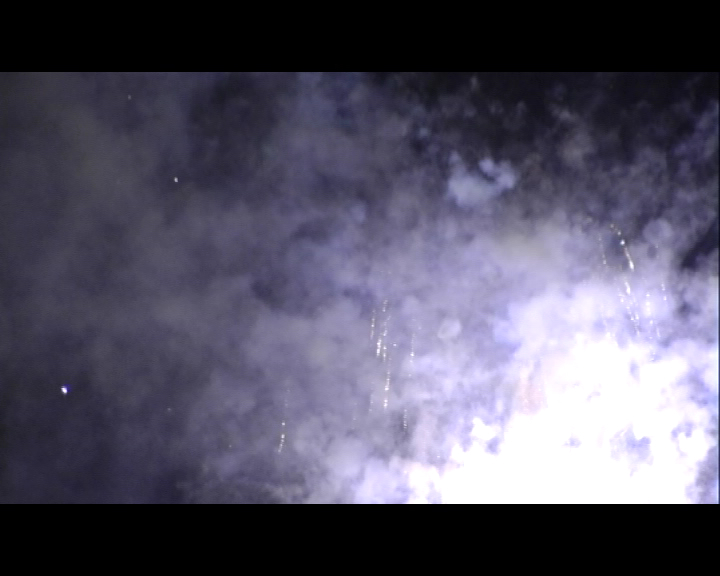ITA/ENG (scroll down)
Roni Lanav & Haidi Motola, Fire Works, 2009, 4’59”, videostill
E.A. Qual è il vostro processo di creazione? Partite da un’immagine, un’idea o altro?
R.L & H.M. Dal momento che lavoriamo insieme e non individualmente, ci influenziamo a vicenda, così, le nostre opere passano attraverso un lungo processo di dialogo e un discorso profondo. Conduciamo molte ricerche in merito all’oggetto delle nostre opere. In generale, i nostri lavori partono sempre da un’idea, da un concetto. Ci sono anche opere che partono da una chiara immagine che si traducono in parole, in un’idea, e poi di nuovo in un’immagine forte principale.
Fire works in particolare fa parte di un più ampio progetto sulla memoria collettiva e sul nazionalismo nella società ebraico israeliana. I fuochi d’artificio sono un’immagine forte e intensa -parte di una cerimonia, in cui ci si riunisce per guardarli, dal fascino unico. Ma c’è anche un altro lato. Lo stesso materiale esplosivo è usato per fare le bombe, per uccidere. L’altro lato sono i palestinesi – la colonna sonora è dei bombardamenti su Gaza. Il giorno stesso di celebrazione è anche il giorno della memoria, memoria di un disastro, della Nakba.
E.A. Ci sono influenze interdisciplinari importanti nei vostri video? Per esempio musica, cinema, pittura?
R.L & H.M. Prima di tutto, siamo influenzati dalla realtà politico-sociale in cui viviamo. Questo è ciò che ci spinge a lavorare, per affrontare le situazioni. Non è la interdisciplinarietà in sé o qualsiasi disciplina particolare, del resto, la questione centrale. Sono il concetto, le idee e il processo che si innesca e determina il mezzo (o il medium). Proveniamo entrambi dalla fotografia e dal video, che ci influenzano largamente, restando sempre aperti ad altri campi, dal documentario alla poesia e alla musica.
E.A. Quali videomakers o registi vi hanno influenzato?
R.L & H.M. Per Fire Works in particolare – Eyal Sivan, Jean Luc Godard, Yael Bartana, e poi…molti altri.
________________________________________________________________________________________
E.A. What is your creation process? From an image or an idea? Or from another?
R.L & H.M. Because we work together and not individually, we are influenced from each other, thus, our works go through a long process of a dialogue and a deep discourse. We always read a lot of researches regarding the subject of our works. In general, our works always start from an idea, from a concept. There are also works, that start from a clear image which we translate to words, to an idea, and then back again to a stronger based image.
Fire works specifically is part of a larger project about collective memory and nationalism in the Israeli-Jewish society. The fire works are a strong and meaningfull image-part of a ceremony, we gather to watch them- a unifing fascination. But there is also another side. The same explosive material is used to make bombs, to kill. The other side are the Palestinians – the soundtrack is from the bombardments on Gaza. The same celebration day is also a memorial day, memorial of a disaster, of the Nakba.
E.A. There are some very important interdisciplinary influences in your videos? For example music, cinema, painting?
R.L & H.M. For first, we are influenced from the social-political reality we live in. That’s what derives us to work, to deal with. It is not the interdiciplinarity in itself or any specific dicipline, for that matter, the issue. It’s the concept, the ideas and the process that leads us and determines the medium (or mediums). We both come from photography and video, so within the art field we are largely influenced from both, but open also to other fields, from documentary to poetry and music.
E.A. Which videomakers or filmmakers have influenced you?
R.L & H.M. Specifically to this work – Eyal Sivan, Jean Luc Godard, Yael Bartana, and many more.

